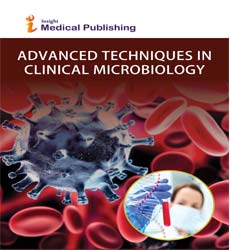The Use of Phytochemicals in the Therapy of Pathogenic Microorganisms is Being Studied
School of Life Sciences, University of Sussex, UK
- Corresponding Author:
- Sam G. Tricker
School of Life Sciences
University of Sussex, UK
E-mail: sam-g.tricker@us.edu
Received Date: October 02, 2021; Accepted Date: October 19, 2021; Published Date: October 29, 2021
Citation: Tricker SG (2021) The Use of Phytochemicals in the Therapy of Pathogenic Microorganisms is Being Studied. Adv Tech Clin Microbiol. Vol.3 No.2:109
Copyright: © 2021 Tricker SG. This is an open-access article distributed under the terms of the Creative Commons Attribution License, which permits unrestricted use, distribution, and reproduction in any medium, provided the original author and source are credited.
Abstract
Antibiotic resistance, also known as microbial drug resistance, is becoming a serious concern to human health around the world, with multidrug-resistant (MDR) strains providing major roadblocks to medication development. Newer antibiotic-resistance mechanisms in microorganisms contribute to existing treatments' inefficacy, as well as prolonged disease and rising costs. Inappropriate use of conventional and widely available antibiotics in human health, hygiene, veterinary, and agricultural operations is proven to be a primary cause of antibiotic resistance evolution, persistence, and transmission at an alarming rate. The lack of new and powerful antibiotics is exacerbating the problem. To treat MDR infections, creative and effective new medications and innovative therapies are critically needed. Plant secondary metabolites, or phytochemicals, are proven effective in treating drug-resistant strains, in addition to the other natural and synthetic medications being explored. Phytochemicals from several classes, such as alkaloids, phenols, coumarins, and terpenoids, have been shown to have inhibitory capability against drug-resistant infections. Several phytochemicals have been found to be effective against the molecular determinants of drug resistance in pathogens, such as membrane proteins, biofilms, efflux pumps, and bacterial cell communication. The rate of translational success, on the other hand, needs to be improved, but the trends are promising.
Keywords
MDR, Phytochemicals, Pathogenic, Ethnomedicinal
Introduction
Plants have medicinal, ritual, and mystical values in the perspective of the locals, in addition to their nutritional worth. Traditional medicinal plants play a vital role in local communities’ health care systems as the primary source of medicine for the vast majority of the rural population. Various plant species and plant-based products are heavily used in these medical systems. Plants have been used as a source of both preventive and curative traditional medicine preparations for humans and cattle since the dawn of humanity. More than 35,000 plant species are used for therapeutic purposes in various human civilizations around the world [1].
According to the World Health Organization (WHO), over 80% of the world’s population receives primary healthcare through traditional plant-based systems [2]. Fransworth and Soejarto [3] agreed, estimating that 70-80 percent of people around the world rely primarily on traditional, mostly herbal medication to address their main healthcare needs. Herbal medicine is still the primary source of primary healthcare for roughly 75-80 percent of the world’s population, primarily in developing nations. This is due to the widespread perception that herbal medications have no negative effects and are inexpensive and readily available [4]. Due to the increasing failure of chemotherapeutics and antibiotic resistance displayed by harmful microbes, researchers are still looking for promising antimicrobial compounds from medicinal plants. It is crucial to emphasise that, despite efforts and advancements in building modern medicine, microbial diseases have remained a big hazard to the world. Microbial infections have a particularly large impact in developing nations, because contemporary medications are scarce and prices are often prohibitive. A focused phytochemical screening, backed up by Ethnomedicinal data, frequently leads to the discovery of new lead compounds that can help with worldwide pathogen-fighting efforts. The rise and spread of multidrug-resistant (MDR) intestinal bacterial infections has put conventional antibiotic therapy under serious jeopardy. MDR enteric bacterial infections are associated with higher mortality, longer hospital stays, and higher treatment and care costs.
The therapy options for pathogens are severely restricted, forcing physicians to rely on expensive or previously discarded medications like colistin, which have serious health consequences for patients. As a result, other prospective alternatives that can be effective in the treatment of these troublesome bacterial infections must be sought. In addition to this issue, antibiotics have been linked to host side effects such as hypersensitivity, immunological suppression, and allergic reactions. Scientists were driven to look for new antibacterial compounds as a result of this circumstance [5].
Conclusion
Antimicrobial activity of the plant extracts was comparable to that of the commonly prescribed contemporary medicines examined. As a result, more clinical efficacy trials, safety, toxicity, and affordability analyses must be conducted as soon as possible in order to progress to the next phase of synthesising precursor molecules for novel effective antimicrobials.
References
- Abbink J (1995) Medicinal and ritual plants of the Ethiopian southwest: an account of recent research. Indigenous Knowledge and Development Monitor 3: 6-8.
- Dery BB, Otsyina R, Ngatigwa C (1999) Indigenous knowledge of medicinal trees and setting priorities for their domestication in shinyanga rejoin, Tanzania. International center for research in agroforestry, Nairobi. Cambridge university press, Britain.
- Philip K, Abd Malek SN, Sani W, Shin SK, Kumar S, et al. (2009) Antimicrobial Activity of Some Medicinal Plants from Malaysia. Am J App Sci 6: 1613-1617.
- WHO (2000) Western pacific region. A report of the consultation meeting on traditional and modern medicine: harmonizing the two approaches. 22-26.
- Carattoli A (2001) Importance of integrons in the diffusion of resistance. Vet Res 32: 243-259.
Open Access Journals
- Aquaculture & Veterinary Science
- Chemistry & Chemical Sciences
- Clinical Sciences
- Engineering
- General Science
- Genetics & Molecular Biology
- Health Care & Nursing
- Immunology & Microbiology
- Materials Science
- Mathematics & Physics
- Medical Sciences
- Neurology & Psychiatry
- Oncology & Cancer Science
- Pharmaceutical Sciences
